Understanding the plots of classic stories helps you see deeper into where stories work or fall apart. Learn how to do plot analysis and reverse outlining in Plottr. Explore Douglas Adams’ satirical classic sci-fi novella, The Hitchhiker’s Guide to the Galaxy.
About the Hitchhiker’s Guide to the Galaxy
British author Douglas Adams’ novella was originally published in 1979. It began in 1978 as a radio comedy show. As of 2022, the book has sold over 15 million copies.
The book follows the hapless Arthur Dent, who awakes one Thursday morning to find council workers approaching to bulldoze his house. They’re clearing the way for a highway bypass. Arthur’s friend Ford Prefect comes to see him, revealing he is an alien and the world will be ending soon.
Aliens arrive shortly after to destroy the Earth for ironically similar reasons. It is in the way of key intergalactic travel routes. Arthur hitches a ride with Ford aboard a spaceship, beginning a wild adventure.
Read on to see how you can use Plottr to reverse outline to see how stories work.
Why Use Plottr for Plot Analysis and Reverse Outlining?
Plottr helps with plot analysis, reverse outlining, and even creating your own study guides. You can use it to:
- Summarize key story units (such as beats, scenes and chapters) and visualize story patterns and gaps that may need filling.
- Keep all your story information in one place. For example, notes, links to useful resources, or inspiring images to reverse-cast your characters.
- Compare narrative arcs against popular plot structures. Compare a story with adventure elements to the Action-Adventure Template in Plottr, for example. This could help you spot key beats in the genre that you could add for more depth and detail.
Ready to do some plot analysis? Download the Plottr summary file for The Hitchhiker’s Guide here if you’d like to follow along.
Steps to Analyze or Reverse Draft in Plottr
We’ll start with the caveat that you don’t have to work in this order! This is just one approach to getting a manuscript’s details into Plottr.
Summarize Each Chapter or Scene in a Scene Card on a Main Plot Plotline
You’ll see this in the demo file of The Hitchhiker’s Guide to the Galaxy linked above. A plotline in blue tracing the key events of each chapter across the novella’s thirty-five chapters.
Whenever you see a new character introduced, consider adding them to the Characters tab.
You can even add custom attributes specifying the page and chapter each character is first mentioned. This is useful if you need to find someone’s first entry fast! (You can also use the Search function in the timeline to see which scene cards mention them).
Add a Plotline Tracking Each Key Character’s Arc or Journey
Below the main plotline you created, add plotlines for each main character tracing their actions. See our Three Little Pigs demo for a simplified example of this.
This will really help with seeing which of your characters have many scenes, and any who has a conspicuously thinner arc.
Use Tags to Sort and Filter Information in Timeline View
Tags are useful for filtering just about anything you can imagine!
Say, for example, you want to see where you’ve included worldbuilding details (or chapters/beats focusing more on worldbuilding than action). Create a tag called “Worldbuilding.” Now you can filter your timeline to see exactly where these moments are in the bigger scheme of your story!
Toggle Between View Sizes
One Plottr hack for plot analysis is to toggle between the L and S (large and small) timeline view sizes. In the small view, the colored circles make it easier to spy where individual characters have a string of scenes (or dip into the background).
This will help you decide whether you need to fill out some characters’ arcs, or whether you want these characters to function more like walk-ons just passing through.
Compare Your Plotlines to Plot Structure Templates
This is where the fun starts. Think about the genre and narrative aspects of your story and what kind of plot structure it might fit.
If you’re writing fantasy, for example, there’s a good chance there will be at least elements of the hero’s or heroine’s journey. Or the action-adventure plot structure.
Add a plotline using a template below your existing plotlines, and see if it helps you come up with additional scenes (or cut extraneous ones that aren’t adding much to the story’s overall impact).
Let’s explore this process using The Hitchhiker’s Guide to the Galaxy!
The Hitchhiker’s Guide to the Galaxy Plot Analysis
The novella takes place across 35 short chapters, running to 159 pages (1979 Pan Books edition).
First, we loaded summaries of all thirty-five chapters’ events into Plottr:

Next, we filled out plotlines for core characters that feature in the book, such as:
Arthur Dent: The protagonist who is whisked away on an intergalactic journey when Earth is destroyed.
Ford Prefect: Arthur’s old friend who is secretly an alien journalist.
Zaphod Beeblebrox: A two-headed, three-armed alien who becomes President of the Imperial Galactic Government just so that he can steal the SS Heart of Gold
and so on.
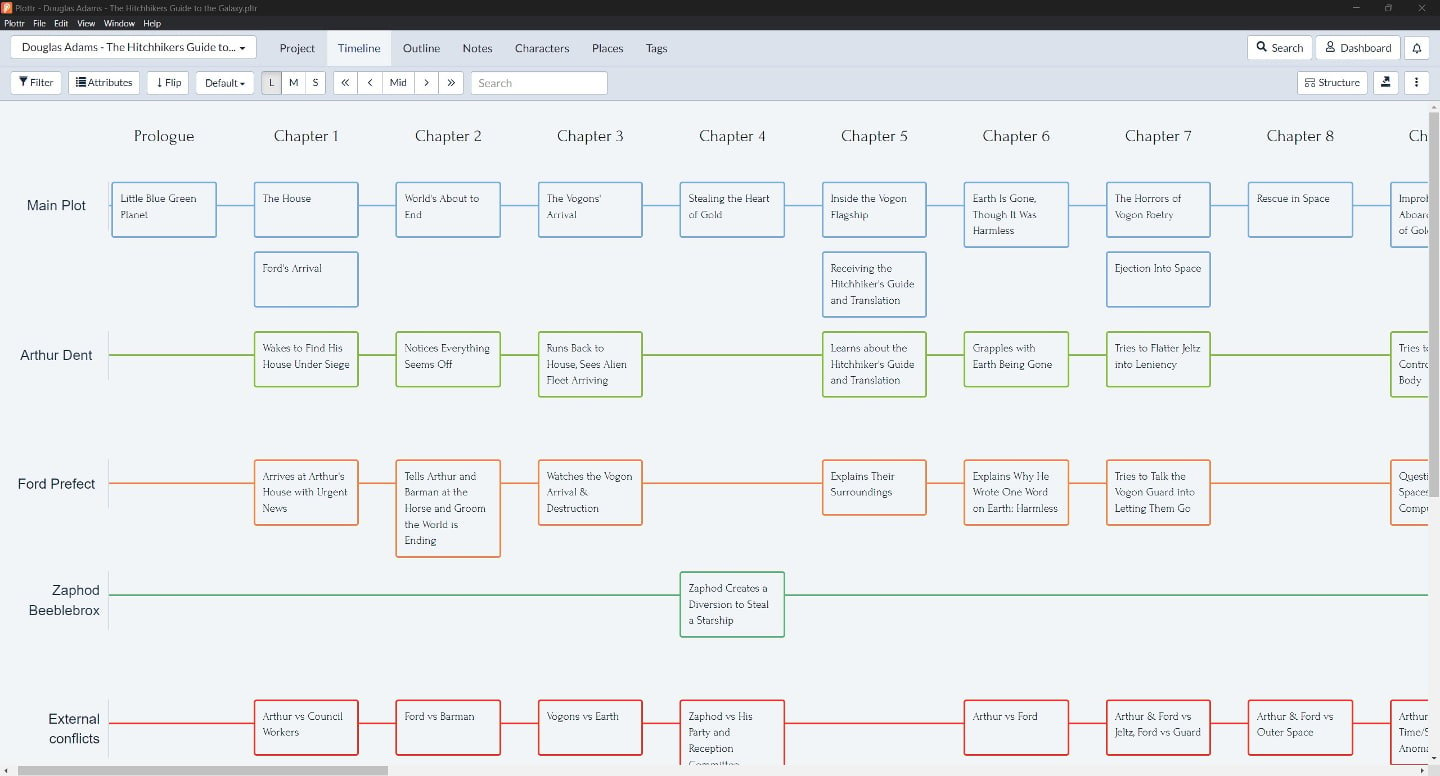
We created character entries for each character in the Characters tab. Here, we noted where they first appear, how they are described, and other details using custom attributes.
Then we set about comparing the plot’s events to popular plot structures. For example, the 24 Chapter Novel seemed like a close-ish fit to a 35-chapter book.
Yet the book also defies conventional, commercial structure. There are entire chapters devoted to mock entries from the book within the book, The Hitchhiker’s Guide to the Galaxy.
It turned out that a simpler, flexible plot structure made the most sense: The Hero’s Journey Short Story.
Reading The Hitchhiker’s Guide to the Galaxy through The Hero’s Journey Short Story
The Hero’s Journey Short Story template (available in Plottr) consists of ten beats:
The Ordinary World
Introduce the Hero and their ordinary world. The Hero has a well-defined need or want, but there is something specific preventing them from acquiring it.
Example from The Hitchhiker’s Guide: Arthur Dent has moved to the English countryside from London and all is going well. Yet normality is destroyed when council workers show up to bulldoze his house. This is the first disruption of Arthur’s ordinary world.
Inciting Incident
Something shocking happens to break the status quo, revealing the obstacles the hero must face.
Example: Arthur’s long-time friend comes to see him to reveal he is an alien and that the world is ending soon (Chapter 2). He convinces Arthur to come to the pub with him after they trick the council workers into pausing the destruction of Arthur’s house.
Hero’s Response
The Hero might vacillate for a short time while they weigh what accepting the call to adventure will mean for them, but ultimately, the Hero accepts the call and enters a new, strange, and intensely unfamiliar situation/world.
Example: Arthur’s reaction is disbelief initially, and he runs back to his house, only to trip and fall. When he looks up, he sees the Vogon alien fleet that intends to destroy Earth approaching. He is saved in the nick of time by Ford hitching them both a lift on a Vogon spaceship.
[There is an intervening chapter introducing the character Zaphod Beeblebrox, Imperial Galactic President, who steals a spaceship, the SS Heart of Gold.]
Trial and Error
The hero enters the new world and tries to attain their goal, to meet the need revealed at the beginning of the story.
They fail, perhaps spectacularly or humorously. Even though the Hero failed, they succeed in either gaining an ally or learning new information. This is a place to show that your character will not give up no matter what and continues to grow.
Example: Aboard the Vogon ship, a try-fail cycle for Arthur begins. He must try to understand Vogon speech (by putting a fish in his ear). This doesn’t help him flatter his way out of jeopardy when the Vogon captain insists on reading Arthur and Ford his tortuous poetry.
Other try-fail events: Arthur must try to accept Earth is no more, but has a hard time letting go of McDonalds. He tries to hold his breath when the Vogon captain ejects Arthur and Ford into space. Fortunately, he and Ford are saved in the nick of time.
Midpoint/Point of No Return
The hero tries to defeat the obstacle that is preventing them from getting what they need. If they succeed, there’s a twist. If they fail, raise the stakes.
Example: After further try/fail cycles (such as Arthur still trying to make sense of his surroundings and failing to, and wanting familiar comforts such as tea), he and Ford, rescued by the stolen spaceship piloted by Zapod Beeblebrox, approach a mysterious planet of legend named Magrathea.
One small hitch: The planet’s ancient defense systems fire missiles at the SS Heart of Gold. They narrowly escape disaster, but have to land on Magrathea due to Zaphod’s insistence as he believes there is ancient treasure on the planet.
Setback
Our hero has failed. They try to go back to the status quo but realize that’s not possible. This is a good time for reflection or perhaps the hero reaches rock bottom and is energized to fight their way out of it.
Example: The party splits up, with Ford, Zaphod and an Earth woman named Trillian whom Zaphod gave a ride to investigating the planet’s subterranean tunnels.
Meanwhile, Arthur who has been left to guard the entrance fails in sticking to this task when he comes across an old man who asks him to accompany him to the planet’s interior aboard his aircraft.
The real setback is when Ford, Zaphod and Trillian are knocked out by an unknown gas in a subterranean chamber, unbeknownst to Arthur.
Acceptance
The hero accepts their fate and trains or otherwise works on removing what is keeping them from reaching their goal.
Their weakness is usually internal, but they are getting it under control.
- Show the hero accepting their failure and acquiring what they need to move forward – this can be an object, knowledge, new abilities, or reconciliation
- Indicate how this acceptance and acquisition of new knowledge and training will play a key role in the hero’s plan
- Allow a moment for the hero to celebrate and perhaps reflect back on all they have been through to get to this point
Example: Arthur has to accept several surprising truths about the nature of reality, Earth’s wider place in the cosmos, and human history. The old Magrathean man he meets reveals that his people built worlds, including Earth, according to the designs of a supercomputer named Deep Thought that predicted Earth would be its successor – a living supercomputer where the sum and complexity of all life would create answers to big questions.
All Is Lost
The one thing that absolutely can’t fail for the plan to work does fail. All hope is lost.
It appears the hero will never be able to solve the problem or defeat their enemy. But wait, all hope is not lost. It’s an incredible long shot, but there is a potential way the hero’s plan could work.
Example: Arthur learns that humans have been an experiment conducted by mice, rather than the other way around, with the lab results of scientific inquiry leading humanity down a specific path.
This series of events leads to a moment where two escaped mice who Trillian brought with her from earth, Benjy and Frankie, tell Arthur they want to remove his brain because they think it holds the answers to life’s great questions (since Arhur hails from the “organic supercomputer” that is Earth).
Cornered and about to have his brain removed, Arthur makes a getaway with his new friends.
Final Attack
It is essential that the hero act immediately. It is now much harder for the Hero to succeed than it was at the mid-point, and the stakes are much higher.
Example: As they’re fleeing Magrathea and the mice, the gang runs into cops from Blagulon Kappa who open fire. Cornered and their cover disintegrating, the group fears all hope is lost.
Wrap Up
Have the hero say goodbye to their allies and return to the ordinary world. Show how the ordinary world has been transformed because of their journey and how the hero has also changed.
The hero can be successful or not, and they may not willingly return to the ordinary world. If not, provide a good motive for them to reluctantly return, such as being chased back or to care for someone they were forced to leave behind.
Example: Back aboard the SS Heart of Gold, Arthur settles into bed to read the Hitchhiker’s Guide to the Galaxy, reasoning that now the galaxy is his home he might as well get to know something about it.
Zaphod comes on over the intercom and asks Arthur if he’s hungry, saying they’re going to grab a bite at the Restaurant at the End of the Universe.
Insights from Reverse Outlining the Hitchhiker’s Guide
There are several interesting insights gained in the process of reverse-outlining this book and analyzing the plot:
- Enduring Sci-Fi Story Opening Structure: From the Star Wars franchise to Douglas Adams’ book, many sci-fi stories begin with heroes who must leave their ordinary world
- Some Characters Serve a Smaller Narrative Purpose: For example, Slartibartfast, the Magrathean who explains the true history of Earth to Arthur, only appears in Chapter 22. As a second mentor-like figure (after Ford), he helps Arthur find a way to move forward in a galaxy where there are so many forces bigger than ourselves
- Try-fail Cycles’ Events May Be Very Eclectic: The chain of Arthur’s try-fail cycles in the story goes through everything from trying to avoid ejection into space by flattering an alien on his cringeworthy poetry to trying to regain control of his body when the SS Heart of Gold’s “Improbability Drive” messes with space-time
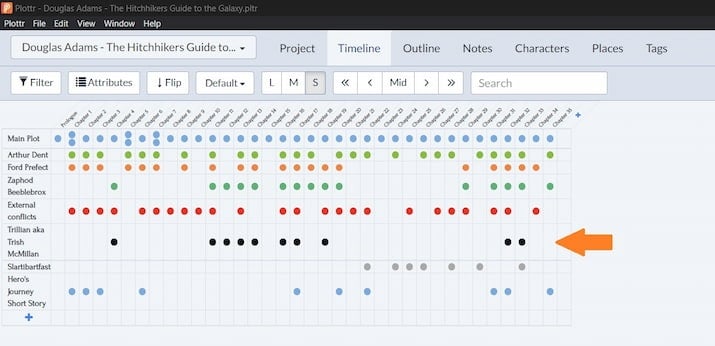
There are many more insights you could glean from looking at the demo file linked above (for example, Trillian’s arc is a little emptier/flatter than the others’).
Start Reverse Outlining in Plottr
Want to see how your favorite stories (or your own next blockbusters) work? Start now with a free trial of Plottr. Tell us in the comments below how you use Plottr for story analysis.
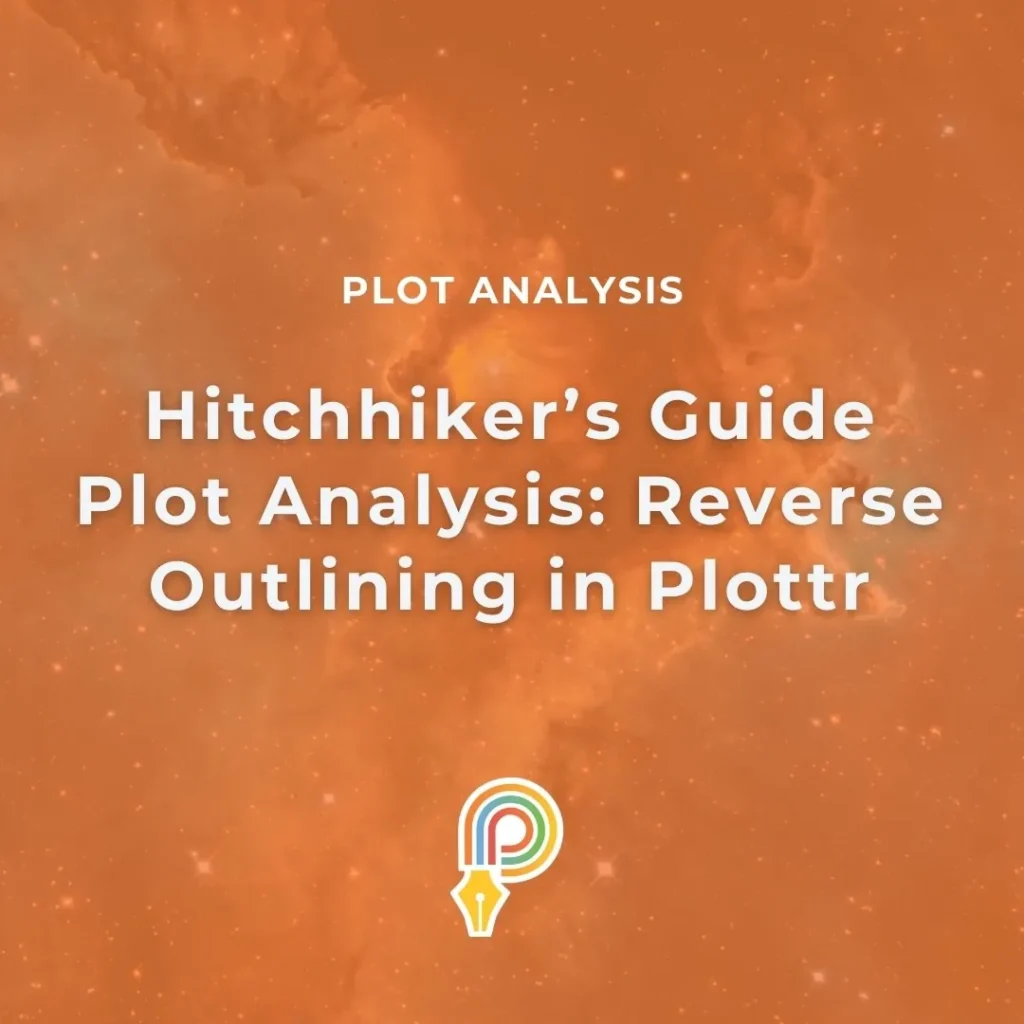

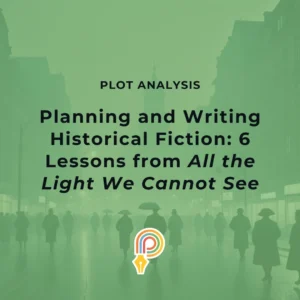

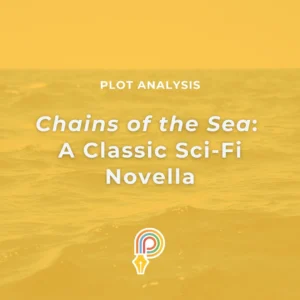
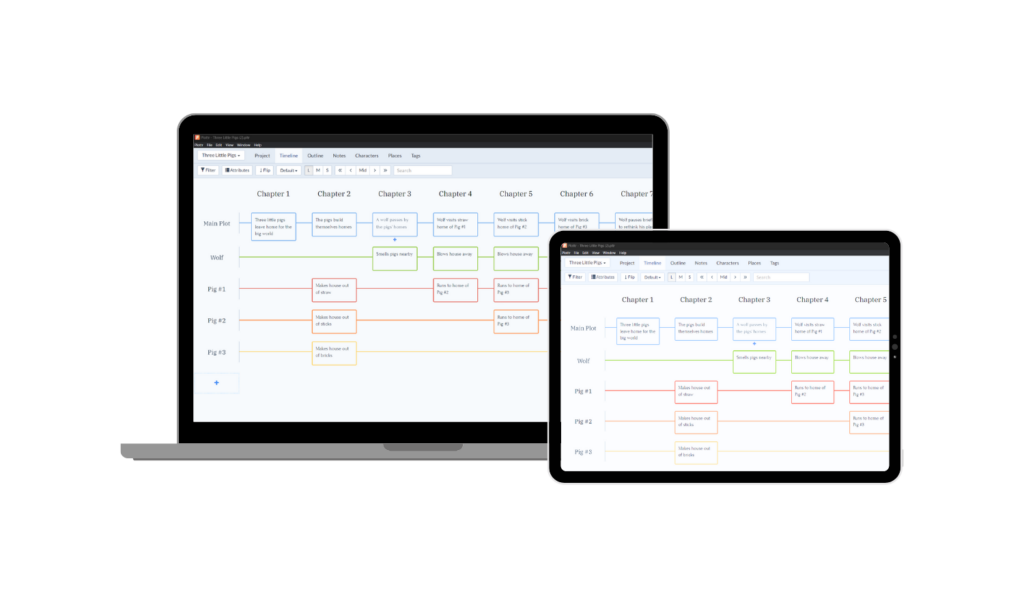
Comments